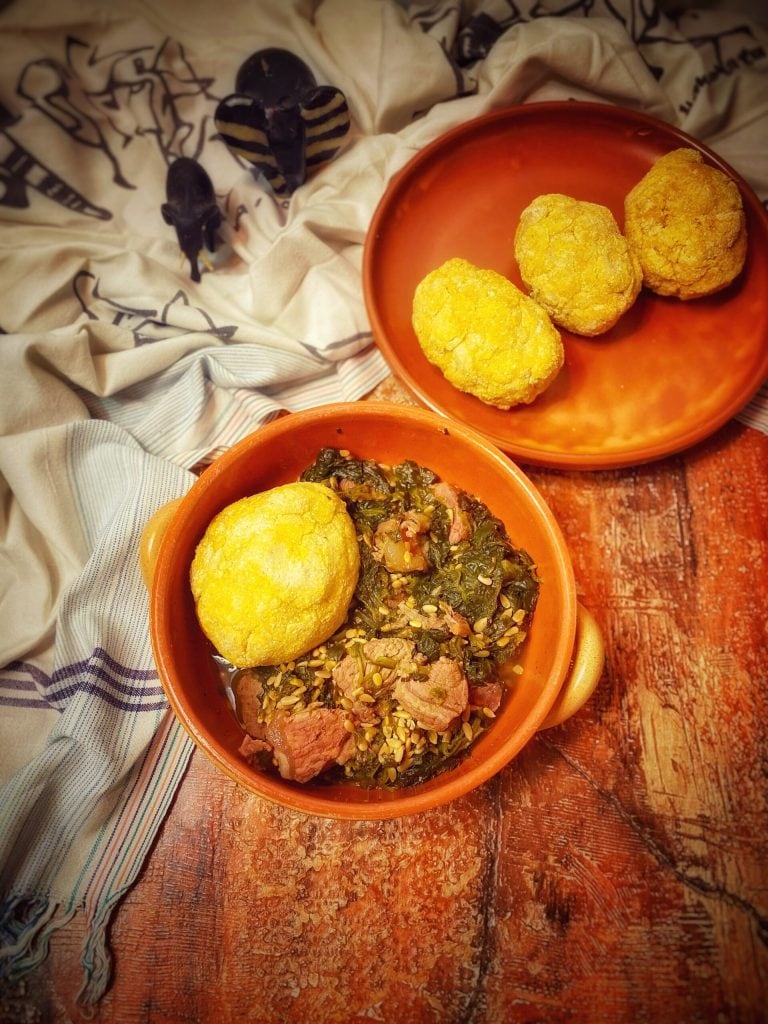Eba and egusi soup are a typical pairing in Nigerian cuisine.
Èbà or Ebe or Pinon (in Togo, Benin, and southern Ghana) is a staple food in Nigeria, Togo, and Benin, also consumed in the West African subregion and other African countries.
The term originates from the Yoruba, an ethnic group in West Africa, and refers to a starchy vegetable food made from grated, dried cassava flour, commonly known as garri throughout West Africa.
Depending on the type of garri flour used, the color can vary from bright yellow to off-white. Often during preparation, palm oil is added to the garri, giving it a bright yellow color.
Not to be confused with ugali, prepared with white corn flour.
Eba is eaten with the fingers, rolled into a small ball, and dipped into thick soups like okra soup, chili paste in Togo, bitter leaf soup, or with okro, ọgbọnọ, or ewédú, meat or fish, stewed vegetables, or other sauces like gbẹ̀gìrì, ofe akwu (banga soup), or egusi soup, which is a beef soup thickened with melon seeds called “egusi.”
Egusi (also known as agusi, egwusi, ohue, Ikpan, Ikon, agushi, or mbàkà) is the name for the protein-rich seeds of certain cucurbitaceous plants (pumpkin, melon, yellow squash), which, after being dried and ground, are used as a main ingredient in West African cuisine.
Besides the seeds, water, and oil, egusi soup typically contains green leafy vegetables like: Efo Tete, scentleaf, okazi/afang (wild spinach), bitterleaf (onugbu), pumpkin leaf (ugu), uziza leaf, celosia, and spinach.
Another Nigerian soup eaten with eba:

- Difficulty: Easy
- Cost: Cheap
- Preparation time: 10 Minutes
- Portions: 4 People
- Cooking methods: Boiling, Stove
- Cuisine: African
- Seasonality: All Seasons
Ingredients
- 2 lbs garri (or cassava flour)
- 3 tbsps palm oil (optional)
- 2 lbs beef
- 2 onions
- to taste egusi (or dried melon seeds)
- 1 chili pepper
- 7 oz spinach
- to taste salt
Steps
Boil 1 quart of salted water, gradually add the garri while stirring continuously with a wooden spatula. If desired, add palm oil, as I did, for the yellow eba version.
Using paper, mold into elongated balls.

Cut the beef into 1-inch cubes.
Place the melon seeds in a bowl with 3 tablespoons of water and one chopped onion.
Cook the beef in 7 oz of water with the other chopped onion for 30 minutes, set aside, and don’t discard the broth.
In a large pot, sauté the melon seeds in palm oil, add the broth, chili pepper, and spinach. Adjust the salt and add the beef. Cook for another 20 minutes and if necessary, add more broth or water.

FAQ (Frequently Asked Questions)
What is garri?
In West Africa, garri (also known as gari, galli, or gali) is the flour of the cassava root.
In the Hausa language, garri can also refer to corn, rice, yam, plantain, and millet flour.
For example, garin dawa is made from corn, garin masara and garin alkama come from corn and wheat, respectively, while garin magani is a powdered medicine.
There are two types of garri, white and yellow; yellow garri is prepared by frying with the addition of palm oil to give it a yellow color.
White garri is fried without palm oil and is slightly more acidic with a stronger flavor.
A variant of white garri is popularly known as garri-Ijebu. This is mainly produced by the Yoruba people of Ijebu in Nigeria.
Garri is similar to Brazilian farofa, used in numerous preparations, especially in the state of Bahia.

